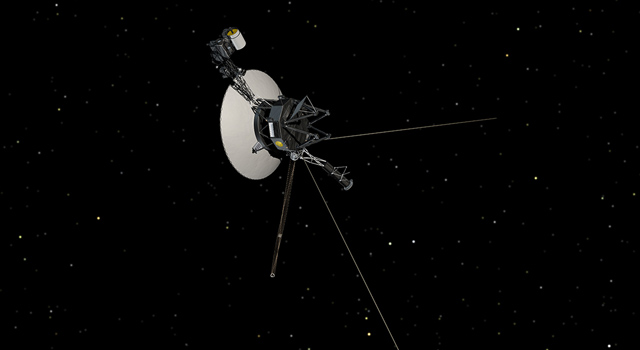News | April 11, 1989
Neptune's Ring Arcs Found

NASA's Voyager spacecraft imaging science team has found two of the long-sought-after ring arcs, or partial rings, thought to exist around Neptune.
The arcs were found in photographs returned by the spacecraft early this morning at NASA's Jet Propulsion Laboratory, Pasadena, Calif.
The two ring arcs are apparently associated with two of the new Neptunian moons also found by Voyager 2 earlier this month. The arcs appear to wrap approximately 45 degrees and 10 degrees, respectively, in the planet's equatorial plane. One is about 50,000 kilometers (about 30,000 miles) in length; the second is about 10,000 kilometers (about 6,000 miles) long.
The first arc, the longer of the two, was seen just outside the moon 1989 N4, which orbits about 62,000 kilometers (38,500 miles) from the planet's center, or about 37,000 kilometers (23,300 miles) from the planet's cloud tops.
The second arc appears to trail the moon 1989 N3 by approximately 90 degrees, or by about 80,000 kilometers or 50,000 miles. That moon orbits Neptune at distance of about 52,000 kilometers (32,300 miles) from the center of the planet, or about 27,300 kilometers (about 17,000 miles) from the planet's cloud tops.
Astronomers have long suspected the existence of such an irregular ring system around Neptune. Data from repeated ground-based observations hinted at the existence of disorderly strands of partial rings orbiting Neptune. Voyager's photographs of the ring arcs are the first photographic evidence that such ring system exists.
Voyager scientists said the ring arcs may be comprised of debris associated with the nearby moons, or may be the remnants of moons that have been torn apart or ground down through collisions. Close-up studies of the ring arcs by Voyager 2 in coming days should help determine their composition.
More ring arcs are expected to be found as the spacecraft nears the planet, Voyager scientists said.
Discovery of the two arcs when the spacecraft was still about 21 million kilometers (13 million miles) from Neptune gives the Voyager team time to schedule detailed photography of the ring arcs when the spacecraft comes within 4,850 kilometers (3,000 miles) of the planet August 24 and 25.
The Voyager mission is conducted by the Jet Propulsion Laboratory for NASA's Office of Space Science and Applications.
